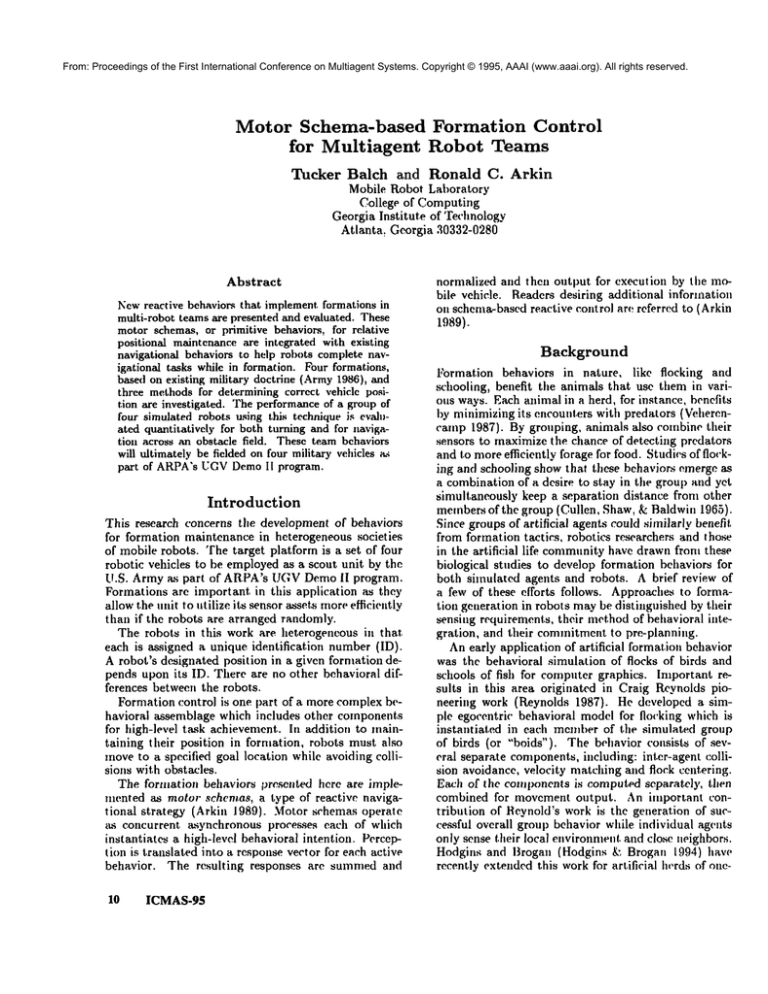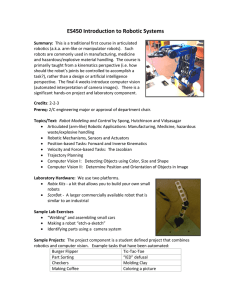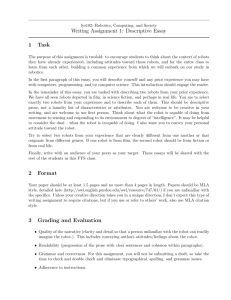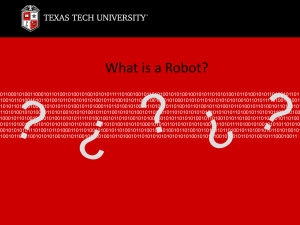
From: Proceedings of the First International Conference on Multiagent Systems. Copyright © 1995, AAAI (www.aaai.org). All rights reserved.
Motor Schema-based Formation Control
for Multiagent Robot Teams
Tucker Balch and Ronald C. Arkin
Mobile Robot Laboratory
College of Computing
Georgia Institute of Technology
Atlanta, Georgia 30332-0280
Abstract
Newreactive behaviors that implementformations in
multi-robot teams are presented and evaluated. These
motor schemas, or primitive behaviors, for relative
positional maintenanceare integrated with existing
navigational behaviors to help robots complete navigational tasks while in formation. Four formations,
based on existing military doctrine (Army1986), and
three methodsfor determining correct vehicle position are investigated. The performanceof a group of
four simulated robots using this technique is evaluated quantitatively for both turning and for navigation across an obstacle field. These team behaviors
will ultimately be fielded on four military vehicles a.~
part of ARPA’sUGVDemoII program.
Introduction
This research concerns the development of behaviors
for formation maintenance in heterogeneous societies
of mobile robots. The target platform is a set of four
robotic vehicles to be employedas a scout unit by the
U.S. Army as part of ARPA’sUGVDemolI program.
Formations arc important in this application as they
allow the unit to utilize its sensor assets moreefficiently
than if the robots are arranged randomly.
The robots in this work are heterogeneous in that
each is assigned a unique identification number (ID).
A robot’s designated position in a given formation depends upon its ID. There are no other behavioral differences between the robots.
Formation control is one part of a more complex behavioral assemblage which includes other components
for high-level task achievement. In addition to maintaining their position in formation, robots must also
moveto a specified goal location while avoiding collisions with obstacles.
The formation behaviors presented here are implemented as motor schemas, a type of reactive navigational strategy (Arkin 1989). Motor schemas operate
a.s concurrent a.synchronous processes each of which
instantiates a high-level behavioral intention. Perception is translated into a response vector for each active
behavior. The resulting responses arc summedand
10
ICMAS-95
normalized and then output for execution by the mobile vehicle. Readers desiring additional information
on schema-basedreactive control are referred to (Arkin
1989).
Background
l"ormation behaviors in nature, like flocking and
schooling, benefit the animals that use them in various ways. Each animal in a herd, for instance, benefits
by minimizing its cncouuters with predators (Veherencamp 1987}. By grouping, animals also combine their
sensors to maximize the chance of detecting predators
and to moreefficiently forage for food. Studies of flocking and schooling show that these behaviors emerge as
a combination of a desire to stay in the group and yet
sinmltaneously keep a separation distance from other
membersof the group (Cullen, Shaw, & Baldwin 1965).
Since groups of artificial agents could similarly benefit
from formation tactics, robotics researchers and those
in the artificial life communityhave drawn front these
biological studies to develop formation behaviors for
both simulated agents and robots. A brief review of
a few of these efforts follows. Approaches to formation generation in robots maybe distinguished by their
sensing requirements, their method of behavioral integration, and their commitmentto pre.-planning.
An early application of artificial formation behavior
was the behavioral simulation of flocks of birds and
schools of fish for computer graphics. Important resuits in this area originated in Craig Reynolds pioneering work (Reynolds 1987}. He developed a simple egocentric behavioral model for flocking which is
instantiate.d
in each memberof the simulated group
of birds (or "boids"). The behavior consists of several separate components,including: inter-agent collision avoidance, velocity matching and flock centering.
Each of the components is computed separately, then
combined for movement output. An important contribution of Heynold’s work is the generation of successful overall group behavior while individual agents
only sense their local environment and close neighbors.
Hodgins and Brogan (Hodgins &; Brogan 1994) have
recently extended this work for artificial herds of one-
From: Proceedings of the First International Conference on Multiagent Systems. Copyright © 1995, AAAI (www.aaai.org). All rights reserved.
-,..:
Figure 1: Formations for four robots (from left to right: line, column, diamond, wedge)
legged animals. Their results are even more visually
realistic than Reynolds’ because they also simulate the
mechanics of motion; Reynolds’ approach utilized particle modelsonly.
The individual components of Reynolds’ flocking
and Hodgins’ herding behaviors are similar in philosophy to the motor schema paradigm used here, but
their approaches are concerned with the generation of
visually realistic flocks and herds for large numbersof
simulated animals, a different problem domain than
the one this paper addresses. In contrast, our research
studies behaviors for a small group (four) of mobile
robots, striving to maintain a specific geometric formation.
The dynamics and stability of multi-robot formations has drawn recent attention (Wang 1991; Chen
& Luh 1994). Wang(Wang 1991) developed a strategy for robot formations where individual robots are
given specific positions to maintain relative to a leader
or neighbor. Sensory requirements for these robots are
reduced since they only need to knowabout a few other
robots, ttis analysis centered on feedback control for
formation maintenance and stability of the resulting
system. It did not include integrative strategies for
obstacle avoidance and navigation. In work by Chen
and Luh (Chen & Luh 1994) formation generation
distributed control is demonstrated. Large groups of
robots are shown to cooperatively move in various geometric formations. This research also centered on the
analysis of group dynamics and stability, and does not
provide for obstacle avoidance. In the approach forwarded in this paper, geometric formations are specified in a similar manner, but formation behaviors are
fully integrated with obstacle avoidance and other navigation behaviors.
Mataric has also investigated emergent group behavior (Mataric 1992b; 1992a). Her work shows that simple behaviors like avoidance, aggregation and dispersion can be combined to create an emergent flocking
behavior on wheeled robots. Her research is in the vein
of Reynolds’ work in that a specific agent’s geometric
position is not designated. The behaviors described in
this paper differ in that positions relative to the group
are specified and maintained for each active robot.
Other recent related papers on formation control for
robot teams include (Parker 1994; Yoshida, Arai,
Yomoyoshi 1994; Gage 1992). Parker’s thesis (Parker
1994) concerns the coordination of multiple heterogeneous robots. Of particular interest is her work
in implementing "bounding overwatch," a military
movement technique for teams of agents; one group
moves(bounds) a short distance, while the other group
overwatches for danger. Yoshida (Yoshida, Arai,
Yomoyoshi1994) investigates how robots can use only
local communication to generate a global grouping behavior. Similarly, Gage (Gage 1992) examines how
robots can use local sensing to achieve group objectives like coverage and formation maintenance.
Approach
Several formations for a team of four robots are considered (Fig. 1):
¯ line - where the robots travel line-abreast.
¯ column - where the robots travel one after the other.
¯ diamond - where the robots travel in a diamond.
¯ wedge - where the robots travel in a "V".
These particular formations were selected because
they are used by mechanizedscout platoons on the battlefield (Army 1986). For each formation, each robot
has a specific position (based on its ID). Figure I shows
the formations and robots’ positions within them. Active behaviors for each of the four robots are identical,
except in the case of Robot 1 in leader-referenced formations (see below).
In this research, the task for each robot is to simultaneously moveto a goal location, avoid obstacles,
avoid colliding with other robots and maintain a formation position (typically in the context of a higherlevel mission scenario). The motor schemas, moveto-goal, avoid-static-obstacle,
avoid-robot, and
maintain-formation,
respectively,
implement these
behaviors.
An additional
background
schema,noise,
serves
as a formof reactive
"grease",
dealing
withsome
of the problemsendemicto purelyreactive
navigationalmethods(Arkin1989).Eachschemagenerates
a vectorrepresenting
thedesired
behavioral
response
(direction
andmagnitude
of movement)
for therobot
Balch
11
From: Proceedings of the First International Conference on Multiagent Systems. Copyright © 1995, AAAI (www.aaai.org). All rights reserved.
._
i
Figure 2: Formation position determined by various reference techniques (from left to right: unit-center,
neighbor)
given the current sensory stimuli provided by the environment. A gain value is used to indicate the relative
importance of the individual behaviors. The high-level
combinedbehavior is generated by multiplying the outputs of each primitive behavior by its gain, then summing and normalizing the results. The gains and other
schema parameters used for the results presented in
this paper are listed in Table 1. See (Arkin ] 989) for
a complete discussion of the computational basis and
parameter definitions for the avoid-statlc-obstacle,
move-to-goal and noise motor schemas.
Parameter
avoid-static-obstacle
gain
sphere of influence
minimumrange
avoid-robot
gain
sphere of influence
minimumrange
move-to-goal
gain
noise
gain
persistence
malntain-formation
gain
desired spacing
controlled zone radius
dead zone radius
I[ Value Units
1.5
50 meters
5 meters
2.0
20 meters
5 meters
0.8
0.1
6 steps
1.0
50
25
0
meters
meters
meters
Table 1: Motor schema parameters for navigation and
formation.
Formation maintenance is accomplished in two
steps:
first,
the perceptual process, detectformation-posltion,
determines the robot’s proper
position in formation based on current environmental
data; second, the motor schema malntaln-formation
generates a movementvector toward the correct location. Each robot must compute its proper position in
the formation for each movement step. Three techniques for formation position determination have been
identified:
lZ
ICMAS-g$
leader,
¯ Unit-center-referenced:
a unit-center
is computed by averaging the x and y positions of all the
robots involved in the formation. Each robot determines its ownformation position relative to that
center.
¯ Leader-referenced: each robot determines its formation position in relation to the lead robot (Robot
I). The leader does not attempt to maintain formation; the other robots are responsible for formation
maintenance.
¯ Neighbor-referenced: each robot maintains a position relative to one other predetermined robot.
These relationships are depicted in Figure 2. Arrows show how the formation positions are determined.
Each arrow points from a robot to the associated reference. The perceptual schema detect-formationposition uses one of these references to determine the
proper position for the robot. The spacing between
robots is determined by the desired spacing parameter of detect-formation-position.
Once the desired formation position is known,
the maintain-formatlon
motor schema generates a
movementvector towards it. The vector is always in
the direction of the desired formation position, but the
magnitude depends on how far the robot is from the
desired position. Figure 3 illustrates three zones, defined by distance from the desired position, used for
magnitude computation. The radii of these zones are
parameters of the maintain-formation
schema. In
the example, Robot 3 attempts to maintain a position to the left of and abeam Robot 1. Robot 3 is in
the controlled zone, so a moderate force towards the
desired position (forward and right) is generated
maintain-formation.
The magnitude of the vector
is computedas follows:
¯ Ballistic zone: the magnitude is set at its maximum,which equates to the schema’s gain value.
¯ Controlled zone: the magnitude varies linearly
from a maximumat the farthest edge of the zone
to zero at the inner edge.
¯ Dead zone: in the dead zone vector magnitude is
always zero.
From: Proceedings of the First International Conference on Multiagent Systems. Copyright © 1995, AAAI (www.aaai.org). All rights reserved.
...--.:
robots’ sensors and actuators are implemented in the
main simulation. Whenone of the robot’s perceptual
processes requires obstacle information for example, a
request for that data is sent via the socket to the simulation. A list comprised of angle and range data for
each obstacle in sensor range is returned. Robot and
goal sensor information is provided similarly. A robot
movesby transmitting its desired velocity to the simulation process. The simulation process automatically
maintains the position and heading of each robot.
Qualitative
Figure 3: Zones for the computation of maintainformation magnitude
Results
Simulation
Environment
®
Figure 4: Typical simulation run showing four robots
in a leader-referenced wedge formation executing a 90
degree left turn.
Results were generated using Georgia Tech’s MissionLab robot simulation environment (MacKenzie,
Cameron, & Arkin 1995). MissionLab runs on Sun
SPAR.Ca under SunOS and the Xll graphical windowing system. The simulation environment is a 1000 by
1000 meter two dimensional "playing field" upon which
various sizes and distributions of circular obstacles can
be scattered. Each simulated robot is a separately running C program that interacts with the simulation environment via a Unix socket. The simulation displays
the environment graphically and maintains world state
information which it transmits to the robots as they
request it. Figure 4 shows a typical simulation run.
The robots are displayed as five-sided polygons, while
the obstacles are black circles. The robots’ paths are
depicted with solid lines.
Sensors allow a robot to distinguish between three
perceptual classes: robots, obstacles and goals. The
Results
The line,
column, wedge and diamond formations have been implemented using the unitcenter-referenced and leader-referenced approaches.
Neighbor-referenced formations are under development.
Figure 5 illustrates robots movingin each of the basic formations using the leader-referenced approach. In
each of these simulation runs the robots were first initialized on the left side of the simulation environment,
then directed to proceed to the lower center of the
frame. After the formation was established, a 90 degree
turn to the left was initiated. Results were similarly
obtained for the unit-center-referenced formations.
Qualitative differences between the two approaches
can be seen as a formation of robots moves around obstacles and through turns (see Figure 6). For leaderreferenced formations any turn by the leader causes the
entire formation to shift accordingly, but whena "follower" robot turns, the others in formation are not affected. In unit-center-referenced formations any robot
moveor turn impacts the entire formation. In turns for
leader-referenced formations, the leader simply heads
in the new direction; other robots must adjust to move
into position. In unit-center-referenced turns, the entire formation initially appears to spin about a central
point, as the robots align with a new heading.
Quantitative
Results
To investigate quantitative differences in performance
between the various formation types and references,
two experiments were conducted in simulation: the
first experiment evaluates performance in turns, and
the second evaluates performance across an obstacle
field.
To evaluate performance in turns, the robots are
commandedto travel 250 meters, turn right, then
travel another 250 meters. The robots attempt to
maintain formation throughout the test. A turn of
90 degrees was selected for this initial study, but performancelikely varies for different angles. In this evaluation, no obstacles are present. For statistical significance, 10 simulations were run for each formation type
and reference. To ensure the robots are in correct formation at the start of the evaluation, they travel 100
meters to align themselves before the evaluation starts.
Balch
13
From: Proceedings of the First International Conference on Multiagent Systems. Copyright © 1995, AAAI (www.aaai.org). All rights reserved.
Figure 5: Four robots in levxler-referenced
diamond, wed#e, line and column formations.
Figure6: Comparison
of leader-referenced
(left)andunit-center-referenced
(right)
diamond
formations.
Thisinitial
100metersis notincluded
in the500meter course.An evaluation
run is completewhenthe
unit-center
of theformation
is within
10 meters
of the
goallocation.
Eventhougha unit-center
computation
isusedto determine
taskcompletion,
it is notrequired
forleader-referenced
formation
maintenance.
Three performancemetricsare employed:path
lengthratio,average
position
error,andpercentof
timeout of formation.
Pathlengthratiois the averagedistance
traveled
by thefourrobotsdivided
by
thestraight-line
distance
ofthecourse.
A lowervalue
forthisratioindicates
betterperformance.
A ratioof
1.02,forexample,
meanstherobotshadto travelan
average
of 2% further
because
theywerein formation.
Position
erroris theaverage
displacement
fromthecorrectformation
position
throughout
the run.Robots
occasionally
falloutofposition
duetoturns,
etc.;
this
isreflectcd
inthepercent
of timeoutofformation
data.
To be "inposition"
a robotmustbe within5 metersof
its correct position. 5 meters was selected arbitrarily,
but amounts to 10% of the overall formation spacing.
Results for the turn experiment are summarizedin Table 2; the standard deviation for each quantity is listed
in parentheses.
Performance was also measured for four robots navigating across a field of obstacles in formation. In
this evaluation, the robots are commandedto travel
between two points 500 meters apart. Obstacles are
placed randomly so that 2% of the total area is cov14
ICMAS-9$
eredwithobstacles
I0to 15meters
indieaneter.
Future
workwillinvestigate
howvarious
percentages
of obstaclecoverage
impacts
formation
performance.
As in the
turnevaluation
above,pathlengthratio,average
position
error,andpercent
outof formation
is reported
foreachrun.Datafromrunson I0 randomscenarios
wereaveraged
foreachdatapoint,
thestandard
deviationof eachfactor
isalsorecorded.
Results
forthis
experiment
aresummarized
in Table3.
Analysis
of Results
For turns in a unit-center-referenced formation, diamond formations perform best. The diamond formation minimizes path ratio (1.03), position crror (6.8
meters) and time out of formation (20.1%). Unitcenter-referenced formations appear to turn by rotating about their unit-center, so robots on the outside
edge of the formation have to travel further in turns.
The improved performance in diamond formations may
refect the smaller "momentof inertia" as comparedto
other formations. In a diamond formation, no robot is
further than 50 meters from the unit-center. In contrast, the flanking robots in wedge, line, and column
formations are 75 meters from thc unit center.
For turns in a leader-referenced formation, wedge
and line formations perform about equally. The line
formation minimizes position error (8.2 meters), while
the wedge formation minimizes time out of formation
(17.3 %). Leader-referenced formations pivot about
From: Proceedings of the First International Conference on Multiagent Systems. Copyright © 1995, AAAI (www.aaai.org). All rights reserved.
Formation Type
Diamond
Wedge
Column
Line
Path Ratio
Unit [
Leader
1.03(0.08)
1.04(0.09)
1.04(0.06)
1.04(0.10)
1.06(0.08)
1.06(0.09)
1.16(0.02)
1.050.06)
Position Error
Unit [
Leader
6.8 (0.2)
11.4 (5.9)
9.4 (4.5)
9.1(6.2)
8.4(5.6)m 21.1 (17.3)
8.2 (5.1)
8.5 (5.5) m
Table 2: Performance for a 90 degree turn for both unit-center
deviation is indicated within parentheses.
Formation Type
Diamond
Wedge
Column
Line
Path Ratio
Unit [
Leader
1.o5(0.04) 1.08(0.05)
1.04 (0.04) 1.08(0.05)
1.05 (0.04) 1.08(0.04)
1.o5(0.05) 1.05(0.04)
Position
Unit [
5.2 (1.9)
5.2 (1.4)
3.4 (1.6)
5.3 (1.5)
Time out of Formation
Unit [
Leader
20.8 (0.3)
21.6 (10.8)
25.6 (6.0)
17.3 (9.6)
22.4 (8.1)
32.4 (22.8)
25.7(7.4) 18.9 (lO.8)
and leader-referenced
formations. The standard
Error
Leader
Time out of
Unit [
7.1(5.0)m 38.9 (15.0)
9.5 (8.4) m 37.9 (9.4)
6.4 (5.2)
23.2 (II.8)
36.1 (10.5)
9.4 (8.5)
Formation
Leader
34.8 (21.8)
37.2 (24.3)
28.5 (20.2)
35.6 (23.8)
Table 3: Performance for navigation across an obstacle field.
the leader in sharp turns. Robots significantly behind
the leader will be pushed through a large arc during
the turn. Line and wedge formations work well because fore and aft differences between the lead robot
and other robots (0 and 50 meters respectively) is less
than that for diamond and column formations (100 and
150 meters). Performance for columnformations is significantly worse than that for line, wedgeand diamond
formations because the trail robot is the farthest back
of all (150 meters).
For travel across an obstacle field, the best performance is found using column formations. Column formations minimize position error and percent time out
of formation for unit-center- and leader-referenced formations. This result reflects the fact that columnformations present the smallest cross-section as they traverse the field. Oncethe lead robot offsets to avoid an
obstacle, the others can follow in its "footsteps."
In most instances, unit-center-referenced formations
fare better than leader-referenced formations. A possible explanation is an apparent emergent property of
unit-center-referenced
formations; the robots appear
to work together to minimize formation error. For instance, if one robot gets stuck behind an obstacle the
others "wait" for it. The unit-center is anchored by
the stuck robot so the maintain-formatlon
schema
instantiated in the other robots holds them back until
the stuck robot navigates around the obstacle. This
does not occur in leader-referenced formations.
Overall path length for robots in a leader-referenced
formation is generally longer than in unit-centerreferenced formations. This may be because any turn
or detour by the lead robot is followed by all four
robots, even if their path is not obstructed by the obstacle the leader is avoiding. A detour by the lead
robot in a unit-center-referenced formation affects the
entire formation, but the impact is 75%leas than that
found in leader-referenced formations since in the unitcenter case an individual robot must shift 4 meters to
movethe unit-center I meter.
Summaryand Conclusions
Reactive behaviors for four formations and two formation types were presented and evaluated. Experiments in simulation show that for 90 degree turns,
the diamond formation performs best when the unitcenter-reference for formation position is used, while
wedge and line formations work best when the leaderreference is used. For travel across an obstacle
field, the column formation works best for both unitcenter- and leader-referenced
formations. In most
cases, unit-center-referenced formations perform better than leader-referenced formations. Even so, some
applications probably rule out the use of unit-centerreferenced formations:
¯ HumanLeader: A human cannot be expected to
reasonably compute a formation’s unit-center on the
fly, especially while simultaneously avoiding obstacles. A leader-referenced formation is most appropriate for this application.
¯ Communications Restricted
Applications:
The unit-center approach requires a transmitter and
receiver for each robot and a protocol for exchanging position information. Conversely, the leaderreferenced approach only requires one transmitter
for the leader, and one receiver for each following
robot. Bandwidth requirements are cut by 75%in a
four robot formation.
¯ Passive Sensors for Formation Maintenance:
Unit-center-referenced formations place a great demand on passive sensor systems (e.g. vision). In
four robot visual formation for instance, each robot
would have to track three other robots which may
spread across a 180 degree field of view. Leader- and
neighbor-referenced formations only call for tracking
one other robot.
Balch
15
From: Proceedings of the First International Conference on Multiagent Systems. Copyright © 1995, AAAI (www.aaai.org). All rights reserved.
Thisresearch
has notyet addressed
variousmodes
of robotfailure.
Communications,
sensor,andmotor
failures
cansignificantly
impacta formation.
Mechanismsto dealwiththesefailures
mightinclude
automaticreconfiguration
of theformation
(renumbering)andapplication
of fault-tolerant
communications
strategies.
Thesebehaviors
arebeingportedto mobile
robotsbothin ourlab,andto MartinMarrietta’s
UGV
DemoII vehicles
withmorecomprehensive
resultsto
be available
in theSummerof 1995.
Acknowledgments
This researchis fundedunderONR/ARPAGrant#
N00014-94-I-0215.
The authorsthankDoug MacKenzie and JonathanCameronwho wrotethe simulation
softwareand helpeddebugthe formation
behaviors.
DougMacKenzie
alsodeveloped
the CNL language
and
compiler
in whichtheformation
behaviors
are implemented.
References
Arkin,R. 1989.Motorschemabasedmobilerobot
navigation. International Journal of Robotics Research 8(4) :92-i
12.
Army. 1986. Field Manual No 7-7J. Department of
the Army, Washington, D.C.
Chen, Q., and Luh, J. Y. S. 1994. Coordination
andcontrolof a groupof smallmobilerobots.In
Proceedings of the IEEE International Conference on
Robotics and Automation, 2315-2320.
Cullen, J.; Shaw, E.; and Baldwin, H. 1965. Methods
for measuring the three-dimensional structure of fish
schools. Animal Behavior 13:534-543.
Gage, D. 1992. Commandcontrol for many-robot
systems. UnmannedSystems Magazine 10(4):28-34.
Hodgins, J., and Brogan, D. 1994. Robot herds:
Group behaviors for systems with significant dynamics. In Proceedings of Artificial Life IV, 319-324.
IEEE.
MacKenzie, D.; Cameron, J.; and Arkin, R. 1995.
Specification and execution of multiagent missions.
To appear IROS-1995.
Mataric, M. 1992a. Designing emergent behaviors:
Fromlocal interactions to collective intelligence. In
Proceedings of the International Conference on Simulation of Adaptive Behavior: From Animals to Animats o, 432-441.
Mataric, M. 1992b. Minimizing complexity in controlling a mobile robot population. In Proceedings of
the IEEE International Conference on Robotics and
Automation, 830-835. IEEE.
Parker, L. E. 1994. Heterogeneous Multi-Robot Cooperation. Ph.D. Dissertation, M.I.T.
Reynolds, C. 1987. Flocks, herds and schools: A
distributed
behavioral model. Computer Graphics
21(4):25-34.
16
ICMAS-9$
Veherencamp,S.L. 1987. Individual,kin, and
groupselection.
In Marler,
P.,andVandenbergh,
J.,
eds., Handbookof Behavioral Neurobiology, Volume 3:
Social Behavior and Communication. Plenum Press.
354-382.
Wang, P. 1991. Navigation strategies for multiple
autonomous robots moving in formation. Journal of
Robotic Systems 8(2):177:195.
Yoshida, E.; Arai, T.; and Yomoyoshi,M. 1994. Effect
of grouping in local communication system of multiple mobile robots. In Proc. I994 IEEE International
Conference on Intelligent Robots and Systems, 808-815.




